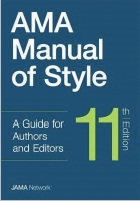Articles
- Page Path
- HOME > Sci Ed > Volume 10(2); 2023 > Article
-
Book Review
The AMA Manual of Style, 11th edition: the ultimate guide to scholarly publishing in the digital age -
Yoon Joo Seo

-
Science Editing 2023;10(2):195-196.
DOI: https://doi.org/10.6087/kcse.307
Published online: July 19, 2023
Infolumi, Seongnam, Korea
- Correspondence to Yoon Joo Seo seo@infolumi.co.kr
• Received: April 5, 2023 • Accepted: May 3, 2023
Copyright © 2023 Korean Council of Science Editors
This is an open access article distributed under the terms of the Creative Commons Attribution License (https://creativecommons.org/licenses/by/4.0/), which permits unrestricted use, distribution, and reproduction in any medium, provided the original work is properly cited.
- 1,919 Views
- 391 Download

-
Conflict of Interest
No potential conflict of interest relevant to this article was reported.
-
Funding
The author received no financial support for this article.
-
Data Availability
Data sharing is not applicable to this article as no new data were created or analyzed in this study.
Notes
Supplementary Materials
- 1. American Medical Association. AMA manual of style: a guide for authors and editors. 1st ed. Williams & Wilkins; 1962.
- 2. American Medical Association. AMA manual of style: a guide for authors and editors. 11th ed. Oxford University Press; 2020.
References
Figure & Data
References
Citations
Citations to this article as recorded by 


 KCSE
KCSE
 PubReader
PubReader ePub Link
ePub Link Cite
Cite

